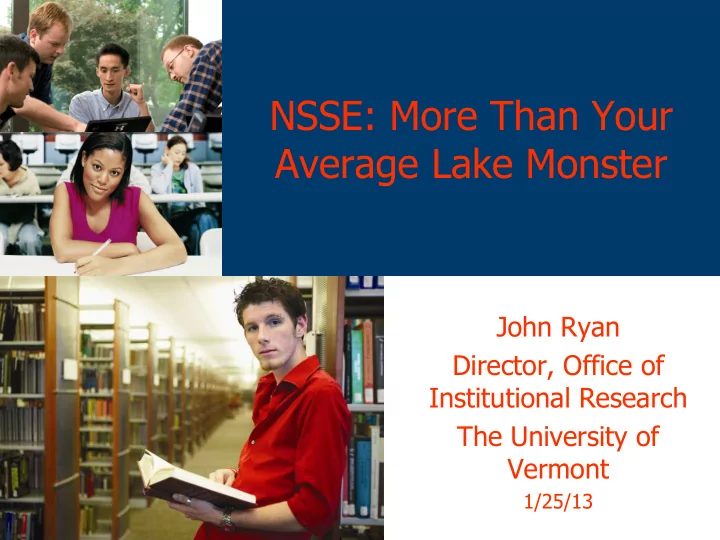

NSSE: More Than Your Average Lake Monster John Ryan Director, Office of Institutional Research The University of Vermont 1/25/13
Presentation Overview § An Introduction: NSSE & Student Engagement § NSSE Uses and Select Results at UVM § Questions & Discussion § Contact Information
An Introduction: NSSE and the Concept of Student Engagement
What is Student Engagement? § What students do -- time and energy devoted to educationally purposeful activities § What institutions do -- using effective educational practices to induce students to do the right things § Educationally effective institutions channel student energy toward the right activities
Foundations of Student Engagement Time on task (Tyler, 1930s) Quality of effort (Pace, 1960-70s) Student involvement (Astin, 1984) Social, academic integration (Tinto, 1987, 1993) Good practices in undergraduate education (Chickering & Gamson, 1987) College impact (Pascarella, 1985) Student engagement (Kuh, 1991, 2005)
Seven Principles of Good Practice in Undergraduate Education (Chickering & Gamson, 1987; Pascarella & Terenzini, 2005) ü Student-faculty contact ü Active learning ü Prompt feedback ü Time on task ü High expectations ü Experiences with diversity ü Cooperation among students
How College Affects Students (Pascarella & Terenzini, 2005) Because individual effort and involvement are the critical determinants of impact, institutions should focus on the ways they can shape their academic, interpersonal, and extracurricular offerings to encourage student engagement . – p. 62
Student Success in College: Creating Conditions that Matter (Kuh, Kinzie, Schuh, Whitt, and Associates, 2005) Illustrates actual institutional policies, programs, and practices that promote student success. § Comprehensive report of in-depth study of successful educational practices across institutional types § Practical guidance on how to implement effective practice in a variety of contexts § Co-sponsored by leading higher education groups (CFAT, Pew Forum on Undergraduate Learning)
NSSE Survey Content Student Behaviors in College Institutional Actions And Requirements Student Learning & Development Student Reactions to College Student Background Information
NSSE Indicators of Effective Educational Practice Active & Level of Academic Collaborative Challenge Learning Enriching Educational Experiences Supportive Student – Faculty Campus Interaction Environment
Survey Administration § Administered to random samples of first-year & senior students across U.S. § Administration occurs in the spring academic term § Paper & Web-based survey § Flexible to accommodate consortium questions § Multiple follow-ups to increase response rates
How Valid is Self-Reported Data? Research Confirms Self-Reported Data Validity When Following Conditions Exist… § Requested information is known to respondents § Questions are clear and unambiguous § Respondents take questions seriously and thoughtfully § Answering does not threaten, embarrass, or violate privacy or compel a socially desirable response The NSSE survey instrument was designed to meet these conditions…but there is ongoing debate For more details, see: NSSE Psychometric Portfolio at http://nsse.iub.edu/html/NSSE_Psychometric_Portfolio.cfm
NSSE Uses and Select Results at UVM
NSSE 2011 Institution Response Rates § UVM’s response rate = 33% § Slightly more female, ALANA similar compared to UVM student population; weighted for comparison reports; participated 2005, 2008, 2011…2014 next Average Institutional Response Rates § 23% for Carnegie Class comparison institutions § 28% for NSSE 2011 Peer Group institutions § 26% for Writing Consortium institutions
NSSE 2011 Select Results § Many strategies for analyzing the results § Comparisons with other universities/groups § “Change” over time at UVM (and relative to other schools) § First year v. senior respondents § Differences among colleges within UVM § Compare similar majors across universities § Predictive modeling for outcomes (learning, development, satisfaction, retention, academic performance) § Cohort tracking (2008 first year respondents and as seniors in 2011)
NSSE 2011 UVM Results § Thinking about your overall experience at this institution, how would you rate the quality of relationships with faculty and administrative personnel and offices (FY)?
Survey says? § What percentage of our first year students would say “quite a bit” or “very much” about the extent to which UVM provides the support they need to thrive socially?
Answer: 55% in 2008 and 48% in 2011 § Thinking about your overall experience at this institution, to what extent does the college provide the support you need to thrive socially (FY)?
Selected Peer Comparison with UVM Results § In thinking about your undergraduate program as a whole, including your major, have you done a culminating senior experience (e.g., senior comprehensive exam, capstone course, thesis or project)?
NSSE 2011 UVM Findings What percentage of our students (in comparison to selected peers) participated in community service or volunteer work? Carnegie Class UVM Peers First-Year 29% 39% Seniors 64% 58%
Survey Says? § What percentage of our FY and SR students reported typically spending more than 15 hours per week studying/preparing for class?
NSSE 2011 UVM Findings What percentage of UVM students spent more than 15 hours per week studying/preparing for class? Class UVM Carnegie Peers First-Year 55% 41% Seniors 42% 42%
Using NSSE at UVM: Student Success and Satisfaction "SENIORS" 2008 NSSE+Engagement+Factors Impact+on+Learning++Factor Impact+on+Personal+Development+Factor Quality+Educational+Experience+Rating Likelihood+you+would+return+if+starting+over Academic(Challenge Active(Collaborative(Learning Student(Faculty(Interaction Enriching(Educational(Experiences Supportive(Campus(Environment SAT(Math SAT(Verbal Female Ethnicity( Hispanic Rank Major(Category Business Transfer Campus(residence Mother's(education Father's(education 2008 NSSE+Engagement+Factors "FIRST+YEARS" Impact+on+Learning++Factor Impact+on+Personal+Development+Factor Quality+Educational+Experience+Rating Likelihood+you+would+return+if+starting+over Academic(Challenge Active(Collaborative(Learning Student(Faculty(Interaction Enriching(Educational(Experiences Supportive(Campus(Environment SAT(Critical(Reading SAT(Critical(Writing SAT(Math Female Ethnicity( Rank Major(Category Professional,+Social+Science,+Other Transfer Campus(residence Mother's(education Attended+college+or+completed+degree Father's(education Attended+but+did+not+complete+college Attended+but+did+not+complete+college
Student Success and Satisfaction "SENIORS" 2008 UVM.Engagement.Factors Impact.on.Learning..Factor Impact.on.Personal.Development.Factor Quality.Educational.Experience.Rating Likelihood.you.would.return.if.starting.over Inclusion)and)Support Active)and)Enriching)Learning Higher8Order)Critical)Thinking Openness)to)New)Ideas SAT)Math SAT)Verbal Female Ethnicity) Hispanic Rank Major)Category Arts.and.Humanities,.Business,.Professional Transfer Campus)residence Mother's)education Attended.but.did.not.complete.college Father's)education Completed.associate.degree Completed.a.bachelor's.degree 2008 UVM.Engagement.Factors "FIRST.YEARS" Impact.on.Learning..Factor Impact.on.Personal.Development.Factor Quality.Educational.Experience.Rating Likelihood.you.would.return.if.starting.over Inclusion)and)Support Active)and)Enriching)Learning Higher8Order)Critical)Thinking Openness)to)New)Ideas SAT)Critical)Reading SAT)Critical)Writing SAT)Math Female Ethnicity) Caucasian,.Hispanic Rank Major)Category Business,.Professional Business,.Professional,.Social.Science,.Other Arts.and.Humanities,.Business,.Professional Transfer Campus)residence Mother's)education Attended.college.or.completed.degree Attended.but.did.not.complete.college Father's)education Completed.a.bachelor's.degree
Student Persistence Likelihood of Persistence Fall 2011-Fall 2012 ë ì Grade-Point Supportive Average Campus Environment
Student Persistence ...and the predictors for the predictors… GPA Supportive Environment -SAT Score -Level of Academic -Active Learning Challenge -Female -Student-Faculty Interaction -Not transfer student -Fewer hrs./wk. working off campus
Recommend
More recommend